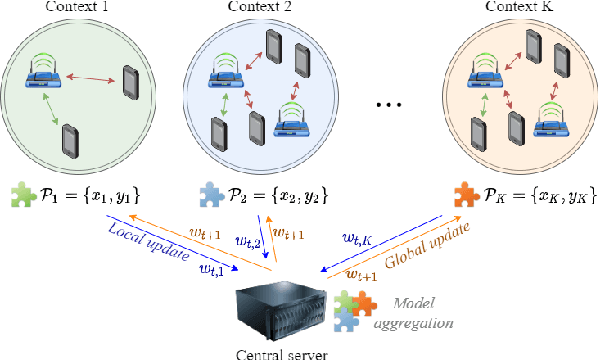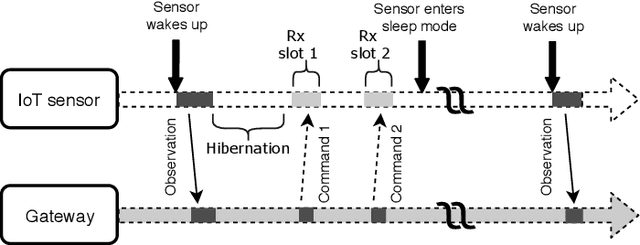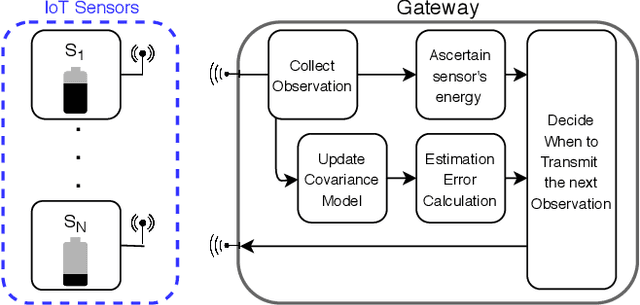Jernej Hribar
The Energy Cost of Artificial Intelligence of Things Lifecycle
Aug 01, 2024Abstract:Artificial intelligence (AI)coupled with existing Internet of Things (IoT) enables more streamlined and autonomous operations across various economic sectors. Consequently, the paradigm of Artificial Intelligence of Things (AIoT) having AI techniques at its core implies additional energy and carbon costs that may become significant with more complex neural architectures. To better understand the energy and Carbon Footprint (CF) of some AIoT components, very recent studies employ conventional metrics. However, these metrics are not designed to capture energy efficiency aspects of inference. In this paper, we propose a new metric, the Energy Cost of AIoT Lifecycle (eCAL) to capture the overall energy cost of inference over the lifecycle of an AIoT system. We devise a new methodology for determining eCAL of an AIoT system by analyzing the complexity of data manipulation in individual components involved in the AIoT lifecycle and derive the overall and per bit energy consumption. With eCAL we show that the better a model is and the more it is used, the more energy efficient an inference is. For an example AIoT configuration, eCAL for making $100$ inferences is $1.43$ times higher than for $1000$ inferences. We also evaluate the CF of the AIoT system by calculating the equivalent CO$_{2}$ emissions based on the energy consumption and the Carbon Intensity (CI) across different countries. Using 2023 renewable data, our analysis reveals that deploying an AIoT system in Germany results in emitting $4.62$ times higher CO$_2$ than in Finland, due to latter using more low-CI energy sources.
Deep W-Networks: Solving Multi-Objective Optimisation Problems With Deep Reinforcement Learning
Nov 09, 2022Abstract:In this paper, we build on advances introduced by the Deep Q-Networks (DQN) approach to extend the multi-objective tabular Reinforcement Learning (RL) algorithm W-learning to large state spaces. W-learning algorithm can naturally solve the competition between multiple single policies in multi-objective environments. However, the tabular version does not scale well to environments with large state spaces. To address this issue, we replace underlying Q-tables with DQN, and propose an addition of W-Networks, as a replacement for tabular weights (W) representations. We evaluate the resulting Deep W-Networks (DWN) approach in two widely-accepted multi-objective RL benchmarks: deep sea treasure and multi-objective mountain car. We show that DWN solves the competition between multiple policies while outperforming the baseline in the form of a DQN solution. Additionally, we demonstrate that the proposed algorithm can find the Pareto front in both tested environments.
Federated Spatial Reuse Optimization in Next-Generation Decentralized IEEE 802.11 WLANs
Mar 20, 2022



Abstract:As wireless standards evolve, more complex functionalities are introduced to address the increasing requirements in terms of throughput, latency, security, and efficiency. To unleash the potential of such new features, artificial intelligence (AI) and machine learning (ML) are currently being exploited for deriving models and protocols from data, rather than by hand-programming. In this paper, we explore the feasibility of applying ML in next-generation wireless local area networks (WLANs). More specifically, we focus on the IEEE 802.11ax spatial reuse (SR) problem and predict its performance through federated learning (FL) models. The set of FL solutions overviewed in this work is part of the 2021 International Telecommunication Union (ITU) AI for 5G Challenge.
Energy Aware Deep Reinforcement Learning Scheduling for Sensors Correlated in Time and Space
Nov 19, 2020



Abstract:Millions of battery-powered sensors deployed for monitoring purposes in a multitude of scenarios, e.g., agriculture, smart cities, industry, etc., require energy-efficient solutions to prolong their lifetime. When these sensors observe a phenomenon distributed in space and evolving in time, it is expected that collected observations will be correlated in time and space. In this paper, we propose a Deep Reinforcement Learning (DRL) based scheduling mechanism capable of taking advantage of correlated information. We design our solution using the Deep Deterministic Policy Gradient (DDPG) algorithm. The proposed mechanism is capable of determining the frequency with which sensors should transmit their updates, to ensure accurate collection of observations, while simultaneously considering the energy available. To evaluate our scheduling mechanism, we use multiple datasets containing environmental observations obtained in multiple real deployments. The real observations enable us to model the environment with which the mechanism interacts as realistically as possible. We show that our solution can significantly extend the sensors' lifetime. We compare our mechanism to an idealized, all-knowing scheduler to demonstrate that its performance is near-optimal. Additionally, we highlight the unique feature of our design, energy-awareness, by displaying the impact of sensors' energy levels on the frequency of updates.
 Add to Chrome
Add to Chrome Add to Firefox
Add to Firefox Add to Edge
Add to Edge